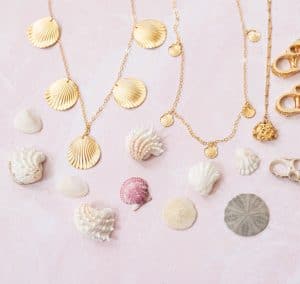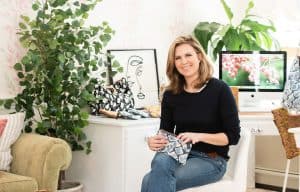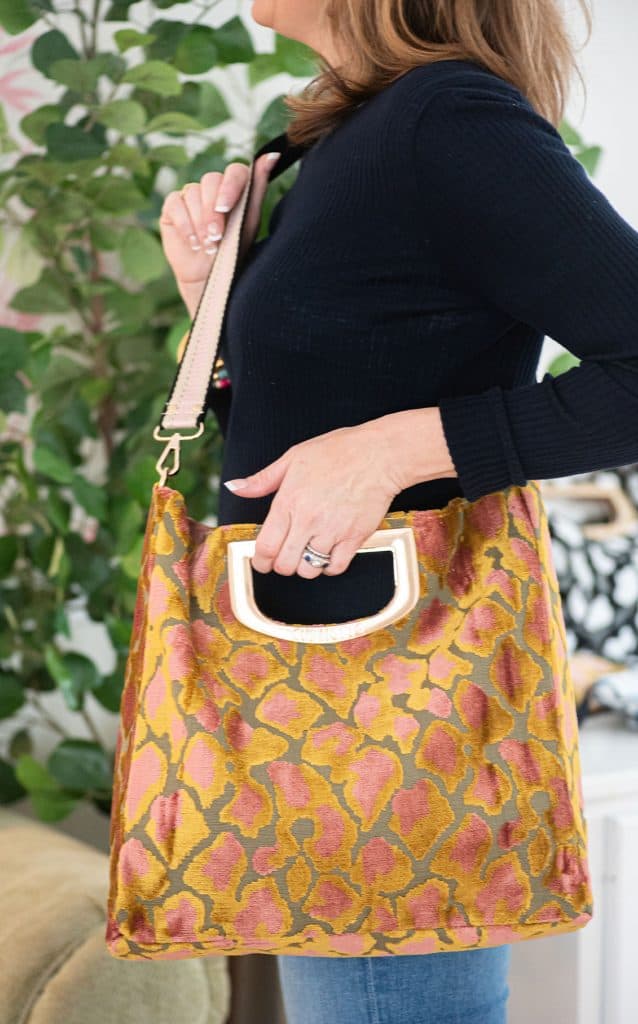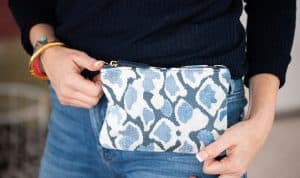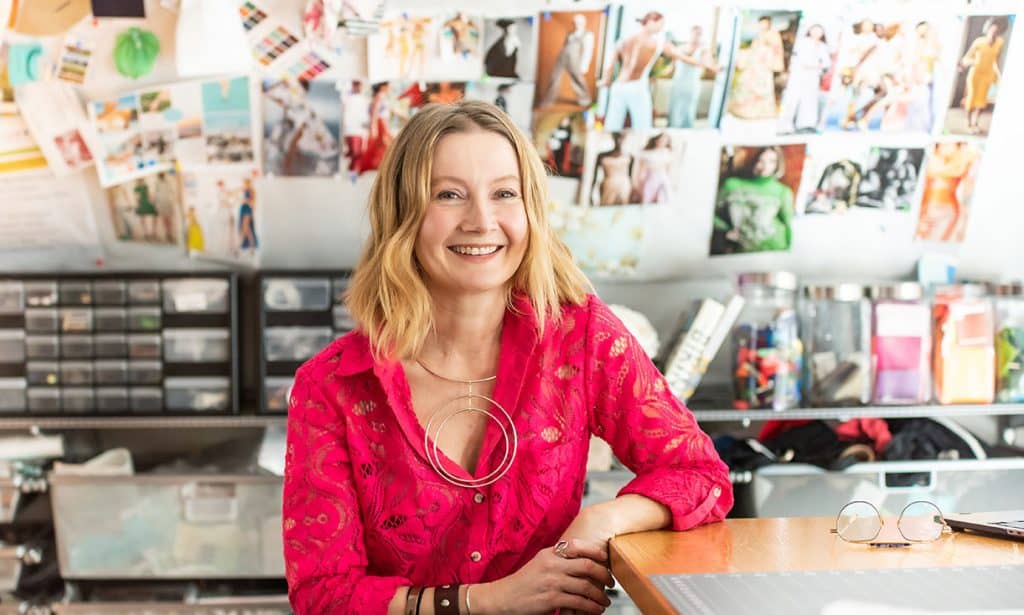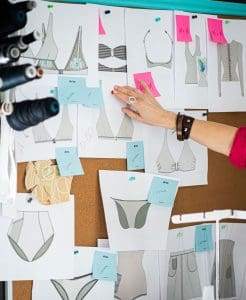By KATHLEEN MCKENNA Photography by KATE ROGAN
Fueled by creativity, the founders of three fashion-forward Hingham businesses have developed a local following by designing boutique apparel and accessory brands. Each has found a way to balance the demands of work and family and adapt to the challenges of a global pandemic, all while transforming their dreams into a reality.
Falk Jewelry Designs
Kerrin Falk began designing jewelry at the age of 10, and sold her earliest designs from a driveway stand at her family’s home in Madison, Connecticut. Her creativity was inspired and encouraged by her grandmother, Patricia, an artist and outdoors enthusiast who was affectionately known to her fellow fisherfolk as “Bluefish Patty.”
“She would give me her old tackle boxes and I used them to organize my beads,”
says Falk, who recalls taking trips to Providence, Rhode Island, and spending “every penny of her babysitting money” on tiny seed beads.
Falk’s grandmother worked in different artistic mediums, often including a seagull design in her artwork, in memory of her late husband. While she never had the opportunity to meet her grandfather, Falk has carried on her family’s legacy by using a seagull
in the logo of her own small business, Falk Jewelry Designs.
“I think because I grew up with art and artists all around me, it became ingrained in my brain,”
says Falk, whose father is a well-known art appraiser and younger sister is a fine artist. Educated at Tabor Academy in Marion, Falk excelled
in painting, drawing, and sculpture.
“By studying all forms of art, you learn to pay attention to the smallest
details,”she says.
She went on to study art history at the University of Texas-Austin, with a focus on Byzantine,
Meso-American, and African art and jewelry. After graduation, she moved to Denver, Colorado, to work
at an art gallery, and it was there that she officially launched her jewelry business in 2010. Two years later,
she and her husband moved back to the east coast and Falk began honing her jewelry-making skills at the Rhode Island School of Design. She learned the art of lost-wax casting, an ancient process where metal alloys are made into a design using a wax mold. As her business has grown, this unique form of jewelry design is one of the things that has set her apart.
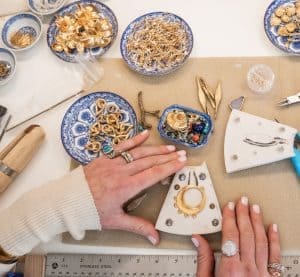 Now settled in Hingham with her husband and three young daughters, Falk spends much of her time designing jewelry in her home studio. She sources precious and semi-precious stones from all over the United States and says that her jewelry designs are inspired by both the urban landscape of Boston and the beaches of the South Shore.
Now settled in Hingham with her husband and three young daughters, Falk spends much of her time designing jewelry in her home studio. She sources precious and semi-precious stones from all over the United States and says that her jewelry designs are inspired by both the urban landscape of Boston and the beaches of the South Shore.
Tiny shells, bits of coral and twigs are cast into one-of-a-kind sterling silver and gold-plated pendants (her collection also includes baby shoelace castings). Custom-made jewelry is Falk’s specialty and she particularly loves working with customers to design pieces that suit their personalities or for special events such as bridal parties and graduations. Birthstone necklaces are a customer favorite and something that is also close to Falk’s heart; she wears a necklace with citrine (November) and sapphire (September) stones in honor of her daughters’ birthdays. “I’ve barely taken it off since I had my third baby, and she’s now 3,” says Falk. On special occasions, she likes to layer her birthstone necklace with one of her “flock” necklaces, an original design that features a series of delicate brass “birds” perched on a chain.
“Jewelry can be so meaningful, with birthstones or healing stones, but you can also make it so sexy,” says Falk. “You can have a simple, elegant piece, or a bold statement piece. I love it all.”
Balancing being a business owner and a parent isn’t always easy. “The days that I don’t set time aside for my business and for myself are hard days,” she says.
“But when I get my work hours in, that time counts as meditation to me because I love it that much. I’m so grateful for that.”
Cushette
Creative career paths are often a long and winding road. This was certainly the case for Catherine McCavanagh, the founder of the handbag brand Cushette. Back when she was a teenager at Notre Dame Academy, she knew she had a passion for fashion, but opted to follow a more traditional academic route, majoring in English at St. Michael’s College in Vermont. After college, McCavanagh had a series of corporate office jobs, but found the work to be unrewarding and she longed to find a way to express her creativity. It wasn’t until she was in her 30s and living in Hingham with her young family that she finally felt empowered to follow her heart and start her own business.
Known for her keen sense of fashion, McCavanagh’s first venture was as a personal shopper and wardrobe stylist. She called her business “The Honest Eye,” and served South Shore clients who needed help curating their wardrobes.
During this same time period, she was busy raising three young children and working as a stylist for the Boston-based agency Anchor Artists, dressing models and assisting on fashion shoots for a variety of retailers (she also helped style and accessorize gymnast Aly Raisman for a profile in People magazine).
McCavanagh’s entrepreneurial spirit really kicked into gear one fateful afternoon when she was flipping through the pages of a coffee table book produced by Vogue, which showcased the interiors of celebrity homes. She found her eyes drawn to a handbag that was resting on the floor of director Sofia Coppola’s office.
“The photo showed a messy artist’s office, with a bag tossed haphazardly on the floor,”
McCavanagh recalls.
“My eyes went straight to the bag, and for some reason I couldn’t get it out of my head.”
McCavanagh started scouring stores to find something similar, but all she found were leather bags, which she knew could easily become damaged.
“I’m the kind of person who always spills her water bottle in her purse,” she says.
For McCavanagh, this was an epiphany moment. She decided that if someone like her—with a proven flair for shopping—was unable to find the perfect bag, she would just have to design one herself. She began sketching out a design for her dream handbag–a luxurious and oversized carry-all with a stylish D-shaped handle. She then started searching for unique cruelty-free fabrics, eventually settling on a durable velvet, normally used in upholstered furniture. McCavanagh added a crossbody strap to her design so she would have the option to either carry the bag or sling it over her shoulder, and she placed pockets and zippers where appropriate. She also selected an incredibly soft faux suede for the lining of the handbag to ensure the interior wouldn’t tear under pressure.
“All my bags have the same dusty-pink lining,” she says. “Because when the lining is too dark, you can’t find anything, and if it’s too light, it can look dirty. My bags are almost softer on the inside than the outside. Everyone who touches them loves the lining.”
McCavanagh hired a company to create a prototype for her design and after months of fine tuning, she finally had a completely customized bag. McCavanagh officially launched her business in April of 2021 and named her new line of handbags Cushette, which was a nod to their soft, velvety fabric patterns. She started taking her new accessory everywhere she went and named it The Duchess, after a childhood nickname her father gave her. McCavanagh also started posting photos of Cushette bags on social media and before long, orders were pouring in.
“A lot of my early purchasers were friends,” she says. “Then the word got out.”
McCavanagh has since created more handbag designs, each with the same distinctive style and fabrics. 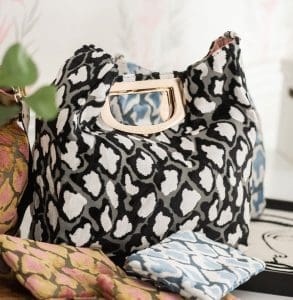 There’s The Midgie, a petite belt bag named after her mother, and The Jane and The Bryce, which were named after her children. McCavanagh currently sells her designs on her website and through a few select retailers. On most days, while her kids are at school, she fills orders from a sunny workspace in the corner of her living room. McCavanagh takes the time to personalize each package with a handwritten thank-you note.
There’s The Midgie, a petite belt bag named after her mother, and The Jane and The Bryce, which were named after her children. McCavanagh currently sells her designs on her website and through a few select retailers. On most days, while her kids are at school, she fills orders from a sunny workspace in the corner of her living room. McCavanagh takes the time to personalize each package with a handwritten thank-you note.
“I write, ‘thank you for purchasing your Cushette, I hope you have fun with it!” she says. “I figure I can take a few minutes to do that.” She also stashes a tiny mesh bag with a pyrite gemstone inside the pocket of each Cushette bag that goes out the door, for good luck. “I always carry it around with me,” she says. “And it turns out, people love it.”
Call to Action Clothing
The Hingham-based apparel company Call to Action Clothing (C2A) is poised to make a big splash in the fashion world this summer when it showcases its 2022 swimwear collection at Miami Swim Week. The brand, which announced its official launch at a pop-up event on Nantucket this past May, is the brainchild of designer and founder Jill Palese, who spent several years perfecting gorgeous designs that are figure-flattering and made as sustainably as possible.
Ironically, Jill Palese isn’t an avid swimmer.
“I’m actually not much of a beach person,” Palese says with a laugh. “I’ve got really fair skin.”
When it comes to textiles, however, there’s a close connection between swimwear and figure skating attire, and Palese grew up as an avid skater. In high school, she created ice-dancing dresses for herself and her teammates.
“I was sewing by the time I was 5 years old,” says Palese, who was born in Wisconsin and raised in New York. “The whole idea of spandex fiber rocked my world.”
Palese earned a degree in design from the Fashion Institute of Technology in New York City before pursuing a career as an activewear designer. A self-professed “textile nerd,” she worked for a swimwear manufacturer early in her career that supplied suits for multiple brands. She recalls being 24 years old and designing a plus-size women’s swimsuit.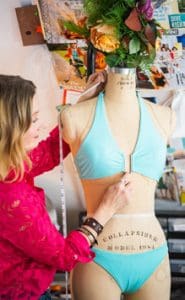
“I just thought about what I would want to wear myself,” she says. “Looking good in a swimsuit isn’t about size, it’s about being confident.”
She put her career on hold while she was raising her family—her daughter is now a sophomore in college and her son is a junior at Hingham High School. But she kept her fashion-industry contacts and nurtured her dream of eventually starting her own swimwear company.
Palese was determined that her company would embrace “slow fashion” and the principles of sustainability. Throughout her career Palese had seen the growing trend toward “fast fashion,” which refers to inexpensive and cheaply-produced clothing that has a notoriously short lifespan, and will quickly be replaced when it wears out or its owner tires of it.
“I really believe in designing clothes that people will wear for a very long time,” says Palese.
She set out to produce a line of swimwear that made women feel comfortable and look beautiful, and that was also built to last. Her company name was inspired by Palese’s hopes for the future of the planet. Her products are designed and manufactured with sustainability practices in place, including reducing the use of water, energy, chemicals and waste, and working with suppliers who share the same environmental practices. Palese has also earmarked a portion of C2A profits to be donated to environmental nonprofit organizations.
Palese hired fellow Hinghamite and technology and apparel executive Dan Rakauskas as her company CEO. Rakauskas has built a niche working with companies that care about sustainability, so Call to Action was right up his alley.
Together, they were just about ready to launch the business when the pandemic hit, and everything turned upside down. A company like C2A, based in the travel and leisure sector, seemed unlikely to survive. Moreover, their factory in the Dominican Republic was deemed non-essential, and forced to shut down. Faced with these barriers, some entrepreneurs would have thrown in the towel, but Palese and her team decided to pivot.
“We looked at each other and said, ‘we’re going into the worst global crisis of our lifetime, and starting this company right now just doesn’t seem like the right thing to do,’” says Palese.
They’d already raised $50,000 in startup capital. They put their product line on hold and decided to use their funds, not to make bathing suits, but to help people on the front lines of the pandemic. They appealed to fashion partners and added to their seed amount, and they called in a few favors from friends. In short order they raised an additional $25,000 and were shipping bolts of fabric to the Dominican Republic.
Ultimately, Call to Action Clothing was able to singlehandedly keep the factory open during the early weeks of COVID. It achieved essential status since Palese arranged for the factory to make 8,500 woven and reusable hospital gowns. Those gowns, crafted from 17,000 yards of nondisposable fabric, were supplied for free to healthcare workers by C2A.
“This was a literal call to action,” says Palese of the steps she had to take for her company’s pandemic pivot. “I knew the factory employees; they’re wonderful people. For them to go for weeks without income, we just had to do something to help.”
Last summer she and her team pivoted again, from hospital gowns back to swimwear.
“I love creating solutions and solving problems,” says Palese of Call to Action’s stalled start, then soft launch, and its current potential. “Now we’re all ready to forge ahead.”


